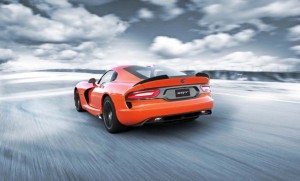It may be one of the fastest cars on the market, but the SRT Viper has also proven to be one of the slowest off dealer lots, and unexpectedly weak sales have forced parent Chrysler to shut down production for nearly three months – though some sources suggest that could stretch on until well into the summer.
The Viper has never been a high-volume product, especially when compared to General Motors’ Chevrolet Corvette. But demand has lagged unexpectedly since the Viper nameplate was revived last year after several years out of production.
Total sales came to just 591 in 2013 and have been on a downward trend this winter – even as Chevy struggles to keep up with demand for the all-new, seventh-generation “C7” Corvette.
Officially, production of the Viper is set to go on hiatus at the end of the week of April 14, with the Connor Avenue Assembly Plant scheduled to start back up during the week of June 23. That move follows an earlier production cut announced last autumn due to weak sales.
The latest move will result in the layoff of 91 workers. It’s also a setback for those who had celebrated the re-opening of the Connor Avenue plant on Detroit’s East Side, one of the few assembly lines left within the borders of the Motor City. Connor was one of two factories Chrysler originally planned to jettison during its 2009 bankruptcy that have been salvaged.
The other, a factory in the Detroit suburb of Sterling Heights, has fared far better. In fact, the newly merged Fiat Chrysler Automobiles last week officially kicked off production of the new Chrysler 200 at that factory, following a major renovation costing the carmaker over $800 million.
(For more on the launch of the 2015 Chrysler 200 and the Sterling Heights plant, Click Here.)
Originally known as the Dodge Viper, the 2-seat sports car was introduced in 1992 to solid reviews. The first model was a bare-bones roadster – it didn’t even offer airbags or antilock brakes. A more sophisticated coupe, the GTS, followed several years later. Over the years, the Viper was upgraded with more high-tech features, often the result of new government mandates, but remained a “pure” sports car, according to Chrysler.
Production was halted in 2010 as Chrysler struggled to pull its finances together post-bankruptcy. But rumors of an all-new Viper quickly surfaced, many reports contending it would be based on a platform from Italian partner Fiat’s Alfa Romeo brand. In fact, the Viper unveiled at the 2012 New York Auto Show – and reassigned to the SRT division – was similar in style to the old model and used largely Detroit-based technology, including its classic, 640-horsepower V-10 powertrain.
(Chrysler demands auto shops, schools destroy rare old Vipers. Click Here for the story.)
Reviews have been more mixed. And it clearly didn’t help to have the new SRT Viper land in showrooms about the same time the new C7 Corvette went on sale – to almost unanimous raves, the Chevy sports car being named North American Car of the Year in January 2014.
A price tag running from $99,395 to $122,995 hasn’t helped Viper’s chances, according to critics. The Corvette, albeit less powerful, starts at around $51,000 and even a fully loaded model will barely climb into the $70,000 range. Chevy will launch a more exotic version, the Z06, a year from now. No price has been announced.
The Connor plant was re-tooled to produce as many as 2,000 Vipers a year, though Chrysler had been hoping to just nudge 1,600. It fell well short of that goal last year, at just 591 and has continued to struggle in 2014, sales for the first two months of the year coming to a mere 91.
(Corvette Museum pulls rare ‘Vettes out of sinkhole. Click Herefor the latest.)

